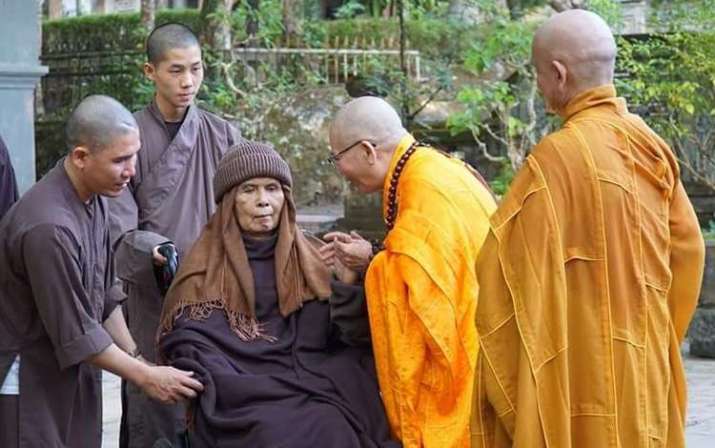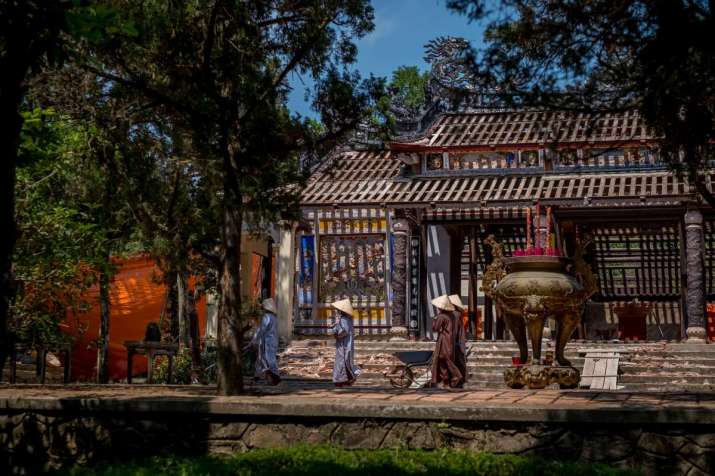NEWS
Thich Nhat Hanh Returns to Monastery in Vietnam Following Renovations
 Thich Nhat Hanh at Hanh Tu Hieu, his root monastery in Hue City, central Vietnam, on 28 May. From e.venexpress.net
Thich Nhat Hanh at Hanh Tu Hieu, his root monastery in Hue City, central Vietnam, on 28 May. From e.venexpress.netThe renowned Zen Buddhist monk and teacher Thich Nhat Hanh has returned to Tu Hieu, his root monastery in Vietnam’s Hue Province, where he has resided since late last year, after vacating the temple complex during a two-week renovation program.
On Tuesday last week, Thay attended a ceremony for the pagoda’s roof after returning from a temporary residence in the coastal resort city of Da Nang.
Thich Nhat Hanh, 92, known affectionately to his followers as “Thay” (teacher), traveled back to his homeland in Vietnam on 26 October last year from Thailand, where he had been convalescing since late December 2016. The celebrated Zen master, who has been recovering from a severe stroke since 2014, said in a letter to his disciples that he had decided to spend the remainder of his life at Tu Hieu Pagoda, where he was ordained as a novice monk at the age of 16.
“The Buddhist knowledge and wisdom I learned from Tu Hieu is now spreading all over the world, and I believe it’s time for me to get back to my roots,” Thay, who is reported to be in stable health, said in his letter. “Students of Tu Hieu are now living and practicing Buddhism in many different places around the world and as a way to remind them of their roots, I want to die here in Tu Hieu.” (VnExpress)
Thay had previously visited Vietnam in 2005, 2007, and 2008, meeting with numerous followers and offering prayers for the country’s war victims. Since his most recent return to Tu Hieu, Thay’s presence has attracted hundreds of followers, some of whom wait for days for a glimpse of him being accompanied around the temple complex in his wheelchair.
“It was the South Vietnamese government that exiled him,” said Sister True Dedication, one of Thay’s monastic disciples and a former BBC journalist. “It was his wish for a long time to come back.” (The New York Times)
Thay was hospitalized in France in November 2014 following a severe brain hemorrhage. After months of rehabilitation, he was released from the stroke clinic at Bordeaux University Hospital in April 2015 and returned to his Plum Village monastic community, where attendants from the monastery and visiting medical professionals continued to aid his recovery. In July of the same year, Thay was flown to San Francisco to undergo a more intensive rehabilitation program at the UCSF Medical Center. In September 2015, Thay spoke his first words since his stroke and in January 2016 was allowed to return to Plum Village, where he remained under the care of the members of his community.
In December 2016, two months after his 90th birthday, Thay communicated a clear and determined wish to travel from France to Thailand in order to be closer to his homeland.* In Thailand, he has been residing at Thai Plum Village on the edge of Khao Yai National Park, the largest practice center in Asia in Thich Nhat Hanh’s tradition, with more than 200 monastic disciples. In August 2017, Thay made his first visit to his homeland Vietnam in more than a decade, spending several days in Da Nang before visiting his hometown in nearby Hue and paying his respects at his ancestral shrine and his lineage’s root temple, Chua Tu Hieu, of which Thay remains the abbot.
 Tu Hieu, where Thay was ordained as a novice monk at age 16. Photo by Linh Pham. from nytimes.com
Tu Hieu, where Thay was ordained as a novice monk at age 16. Photo by Linh Pham. from nytimes.comBorn Nguyen Xuan Bao in central Vietnam on 11 October 1926, Thay is an influential Zen teacher, poet, and the author of more than 100 books, including the bestselling The Miracle of Mindfulness. As an active advocate for peace, he was influential in the anti-war movement, encouraging non-violent protests during the Vietnam War. Before leaving Vietnam, he spearheaded a movement by Buddhists in the south calling for a negotiated end to the bloody conflict. In 1967, he was nominated for the Nobel Peace Prize by Martin Luther King, Jr., who told the Nobel committee: “I do not personally know of anyone more worthy of the Nobel Peace Prize than this gentle Buddhist monk from Vietnam.” (Plum Village)
Thay founded the Order of Interbeing and the Unified Buddhist Church, and in 1982 established the Plum Village Buddhist Center in France with his colleague Sister Chan Khong. He has been a central figure in the transmission of Buddhism to the West and in marrying an authentic Zen tradition and lineage with a progressive approach to issues such as social activism, science versus faith, and religion versus spirituality.
See more
Buddhist monk Thich Nhat Hanh moves back to pagoda after renovation (VnExpress)
Zen Master Thich Nhat Hanh returns to Vietnam (VnExpress)
Vietnam’s influential Buddhist leader says he is back home for good (VnExpress)
Thich Nhat Hanh, Preacher of Mindfulness, Has Come Home to Vietnam (The New York Times)
Plum Village
Related news from Buddhistdoor Global
Thich Nhat Hanh Returns to His Roots in Vietnam
Monks and Nuns of Plum Village Mark Thich Nhat Hanh’s 92nd Birthday
Thich Nhat Hanh’s The Art of Living Wins Gold Nautilus Book Award
Thich Nhat Hanh Returns to Vietnam for the First Time in a Decade
Walk With Me Documentary About Thich Nhat Hanh’s Plum Village Community Premieres at SXSW
Related features from Buddhistdoor Global
Driving at Night
Buddhistdoor View: Thich Nhat Hanh’s Peerless Influence














